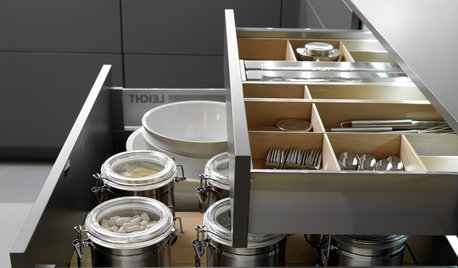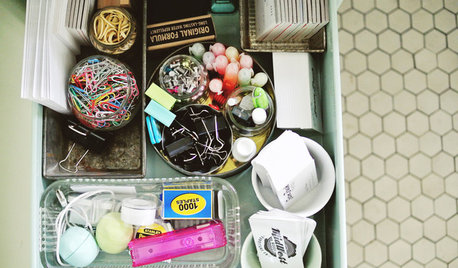Whats this sticky residue and how to get rid of it
eileenlaunonen
14 years ago
Featured Answer
Comments (32)
annie1992
14 years agoRelated Discussions
Getting rid of drain cleaner residue
Comments (3)Update: The answer to this turns out to be the answer to practically everything: Magic Eraser. It's definitely a white residue on stones that are dark grey through and through. I may need to have them resealed, but Magic Eraser is taking the stuff off and getting me back down to the stone....See MoreHelp with stripping paint off wood, remaining sticky residue
Comments (5)Just tyi, the sticky residue is I think because you left it on too long and it dried. You want to remove the stripper when it's still wet. If you have a lot of old layers of paint, put the stripper on thick and cover it with plastic and remove it the next day. The plastic will keep the stripper from drying out....See MoreSide note to getting rid of bermuda-How do you get rid of Oxalis?
Comments (9)The common yellow oxalis we have here has tiny "bulbules" (sp?), which lurk 12 -18 inches under the ground. You can easily pull up the plants, of course, but those tiny bulb things stay under the soil, and up it comes again. I once had a gardener who decided to eradicate it from a flower bed which is about 12 feet long and 6 feet wide. He actually dug up the top 2 feet of soil, and sifted it by hand to get all of the tiny bulbs out. That worked for the first year, but by 2-3 years after he did that, back the oxalis came. So, being lazy, what I do is just admire it in the Spring, except where it is trying to smother other plants. Then just pull it out around those plants. By late Spring here it has died down, and I pretend it is gone. Of course, it comes up again the next Spring. It is one of our first blooming plants to bloom (starts Jan/Feb), so I just regard it as such and let it be mostly. One of my cats likes to eat it (we used to eat it as children - we called it "sour grass"). Jackie...See MoreWhat pest bores into green buds and leaves a sticky residue?
Comments (1)It could be that a caterpillar is to blame. They can be very hard to find as many are green. Could luck finding the culprit Lisa....See Moreann_t
14 years agocentralcacyclist
14 years agolindac
14 years agocolleenoz
14 years agojessyf
14 years agojessicavanderhoff
14 years agovelodoug
14 years agolindac
14 years agoannie1992
14 years agobeanthere_dunthat
14 years agosailfish
14 years agodgkritch
14 years agoaliceinmd
14 years agobeanthere_dunthat
14 years agocolleenoz
14 years agodgkritch
14 years agopetaloid
14 years agocanarybird01
14 years agosailfish
14 years agoeandhl
14 years agojessyf
14 years agoeileenlaunonen
14 years agokframe19
14 years agorandy
6 years agogardengal48 (PNW Z8/9)
6 years agoAlfred Charles Greiner
10 months agobragu_DSM 5
10 months agoLars
9 months agoseagrass_gw Cape Cod
9 months agodcarch7 d c f l a s h 7 @ y a h o o . c o m
9 months agolast modified: 9 months ago
Related Stories

MOST POPULARHow to Get Rid of Those Pesky Summer Fruit Flies
Learn what fruit flies are, how to prevent them and how to get rid of them in your home
Full Story
EDIBLE GARDENSNatural Ways to Get Rid of Weeds in Your Garden
Use these techniques to help prevent the spread of weeds and to learn about your soil
Full Story
KITCHEN DESIGNHouzz Call: What’s Cooking in Your Kitchen?
Most of us turn to recipes, videos and culinary shows when we cook. Where do you set your cookbook, tablet or TV screen?
Full Story
RUGS10 Tips for Getting a Dining Room Rug Just Right
Is the rug you’re considering the right size, shape and weave for your dining room? Here’s what to keep in mind
Full Story
HOUSEKEEPINGThe Best Way to Get Your Windows Spotlessly Clean
Learn the pros’ tips and tricks for cleaning windows and getting them streak-free
Full Story
HOUSEKEEPINGHow to Clean Grout — Stains and All
If your grout is grossing you out, this deep-cleaning method will help it look new again
Full Story
MOST POPULAR5 Ways to Pare Down Your Stuff — Before It Gets in the Door
Want to free up some room around the house? Rethink gift giving, give yourself a shopping mantra and just say, ‘No, thank you’ to freebies
Full Story
LIFE3 Ways to Get Unstuck — About Organizing, Decorating, Whatever
Break out of the do-nothing rut to accomplish your goals, whether at home or in other parts of your life
Full Story
KITCHEN DESIGNGet It Done: Organize Your Kitchen Drawers
Clear 'em out and give the contents a neat-as-a-pin new home with these organizing and storage tips
Full Story
MOST POPULAR8 Ways to Get a Handle on the Junk Drawer
Don’t sweat the small stuff — give it a few drawers of its own, sorted by type or task
Full Story


dedtired